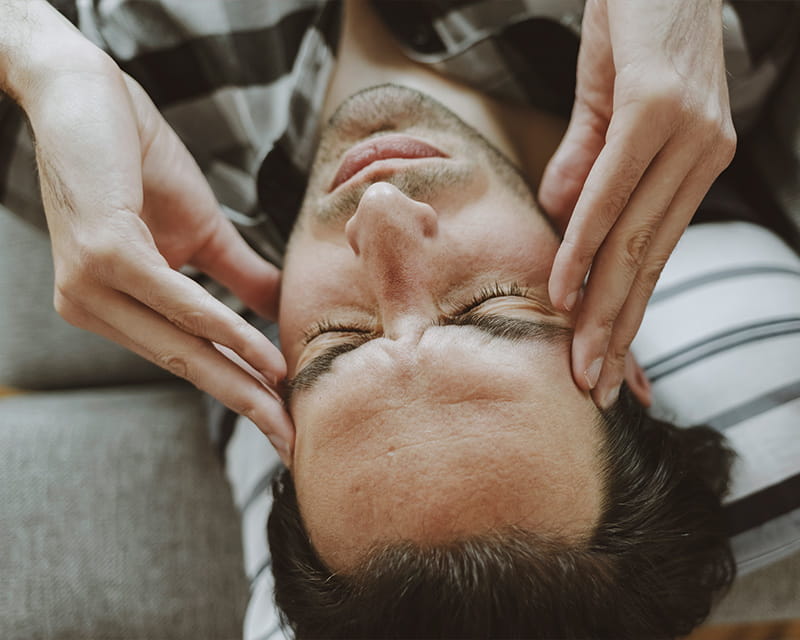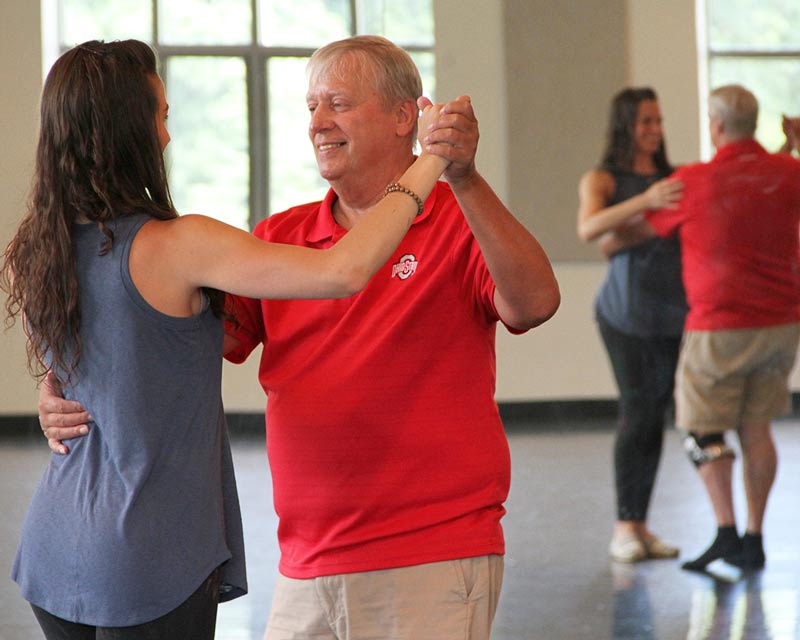
An innovative treatment for chronic post-traumatic headaches
 Rhythmic music could ease life-altering concussion symptoms, Ohio State research finds
Rhythmic music could ease life-altering concussion symptoms, Ohio State research finds
You can’t just “shake it off” when it comes to the debilitating effects of a concussion. But can you “dance” it off?
Researchers in the Department of Physical Medicine and Rehabilitation at The Ohio State University Wexner Medical Center are biometrically analyzing an innovative technique to help concussion patients recover more completely — and it involves the rhythmic beat of tango music.
“Our preliminary data shows that listening to tango music at a pleasant volume helps concussion patients regain their sense of balance and overall wellness,” says Lise Worthen-Chaudhari, PhD. “And actually moving and dancing to the tango rhythm helps even more.”
Worthen-Chaudhari is a research scientist and former professional dancer who has an extensive background in the study of neurorehabilitation, biomechanics, and the math and science of movement.
Her search for new methods of treating debilitating concussion symptoms could help many: It’s estimated that half the world’s population will have a brain injury in their lifetime, and the vast majority of those will be concussion.
This novel study of tango music as a concussion rehabilitation tool is happening in the Motion Analysis and Recovery Biomechanics Laboratory in the Department of Physical Medicine and Rehabilitation at the Ohio State Wexner Medical Center.
Study participants are people who’ve suffered concussions due to car accidents, sports injuries, falls on ice, domestic violence or other causes. They’re experiencing life-altering symptoms that linger long after the incident.
“We specialize in these hard cases. Our patients have a brain injury. They’ve lost a lot of function and can’t seem to get back to work, and their loss of function impacts their quality of life chronically,” Worthen-Chaudhari explains. “People tell them to ‘just shake it off,’ but their brain is not letting them shake it off. It’s injured.”
Lingering concussion symptoms may include:
“Patients report they don’t feel like themselves. That’s because, in the aftermath of their concussion, things really are different on the inside,” Worthen-Chaudhari says.
In the search for an effective rehab solution for concussion, Worthen-Chaudari chose to study tango because of its cadence — its playful, calming rhythm. “Rhythmic music has been shown to neurologically organize, or calm, the system,” she says. “The system response to rhythm is optimized at about 120 beats per minute. The cadence of tango happens to be about 120 beats per minute, too.”
As participants listen to that rhythmic stimulus, she explains, there’s an “entrainment” that happens at the level of the brain.
“The body’s motor system — the movement system — actually improves tangibly, simply from having a rhythm to organize it.”
Other researchers have studied tango as a way to stop the neurodegenerative decline of people with Parkinson’s disease. Worthen-Chaudhari’s lab seeks to advance the concept with neurotrauma patients — to determine whether tango music rehab will actually improve their overall well-being.
“My hypothesis is that tango music offers a rhythmic auditory stimulation for concussion patients that helps their body calm down, feel better and perform better,” she says.
Before Worthen-Chaudhari turns on one beat of tango music, she asks each concussion patient to stand on a high-tech balance platform the size of a scale. With a special laptop computer, she takes biomechanical measurements to check the individual’s balance, one of the lingering symptoms of concussion.
“We measure their postural control, or sway, at a thousand times a second for 30 seconds,” she explains.
Then, she turns on the tango music.
“When I put the music on, there is a statistically significant change in the way their body sways,” Worthen-Chaudhari says. “Our preliminary data shows that when people with concussion stand on the platform listening to music, it normalizes their balance. Their balance shifts closer to normal.”
Next, Worthen-Chaudhari asks concussion patients to dance to the tango music. Yes, this former professional dancer actually dances the tango with them.
“After we’ve danced to a few songs, they relax and breathe and laugh,” she says. “We retest their balance. The preliminary data shows that even three or four songs of dancing and relaxing to music for 15 minutes seems to alleviate patient-reported symptoms and stabilize postural control.
“Postural control improves even more after dancing to tango music than it does after listening.”
The idea is that, when patients learn to relax and breathe more easily — as they do while dancing to tango — they can function better and their concussion symptoms will improve and not dominate their everyday lives.
Worthen-Chaudhari examines her study data with W. Jerry Mysiw, MD, medical director of the Traumatic Brain Injury Program and Susan Bowman Burpee, APRN-CNP, a nurse practitioner in the Department of Physical Medicine and Rehabilitation, in addition to Eugenia Costa-Giomi, PhD, from the Department of Music and Catherine Quatman-Yates, PhD, from the Division of Physical Therapy.
Their study is funded by the Ohio State University Chronic Brain Injury Discovery Theme Initiative. They’ve been studying tango for about two years and are now preparing to publish their results.
Bottom line: Listening to tango music at a pleasant level seems to partially alleviate symptoms, and the movement associated with dancing to tango helps patients even more, stabilizing postural control in addition to symptoms. Worthen-Chaudhari says the goal is to help individuals figure out how they can use the tango music paradigm to feel better in their everyday lives — possibly with a “dance night” every now and then.
“People don’t want to take lots of medicines. They want something they can do on their own time, within their control, that makes them feel well,” she says. “The hope is that people can adopt a fun, new hobby — whether it’s dancing or something else with music — that actually improves their concussion symptoms and helps them recover.”